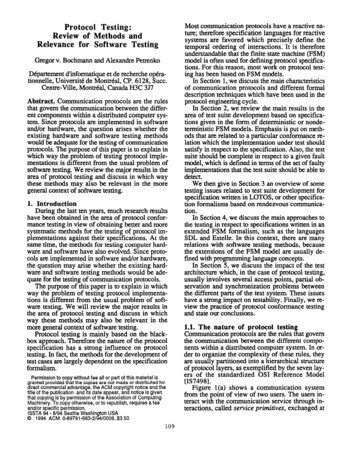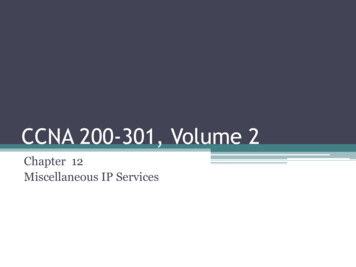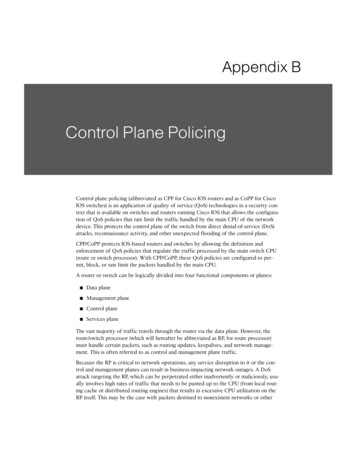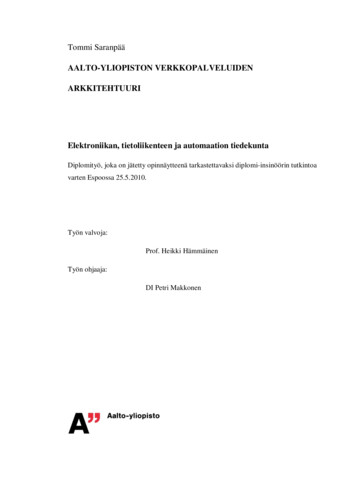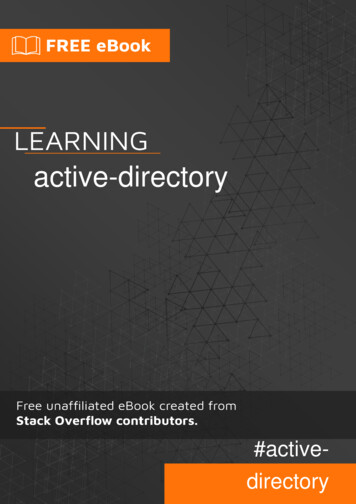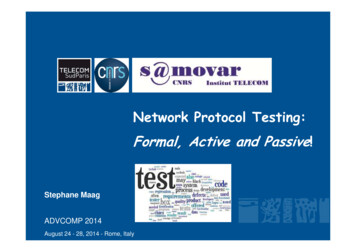
Transcription
Network Protocol Testing:Formal, Active and Passive!Stephane MaagADVCOMP 2014August 24 - 28, 2014 - Rome, Italy
IntroductionWhat is TESTING ?! It is Not:“I’ve searched hard for defects in this program, found a lot of them and repaired them. Ican’t find any more, so I’m confident there aren’t any. “ (Hamlet, 1994) It is :“A process of analyzing an item to detect the differences between existing and requiredconditions, and to evaluate the features of the item.” (ANSI/IEEE Standard 1059)To summarize (briefly!): Meets the requirements, Works as expected, Is implemented with the same characteristics.Many stages or phases are needed 2Stephane Maag / TSPADVCOMP 2014, August 24 - 28, 2014 - Roma, Italy
What we want to Test? Our targets: ITU, ITU-T (ITU-TX.224, )ISO (ISO 7498, )IEEE (IEEE 802.11, )ETSI (ISDN, SS7)IETF (routingprotocol, ) Protocols But, in our presentation: not the Software or programs! Network devices (and its embedded components)Communicating systems (clouds, WS, IMS based, )Information SystemsEtc.we focus on black box testing.3Stephane Maag / TSPADVCOMP 2014, August 24 - 28, 2014 - Roma, Italy
Why to test?specifySystemIdeasConforms tohasdevelop4Stephane Maag / TSPADVCOMP 2014, August 24 - 28, 2014 - Roma, Italy
From the Ideas to the SystemspecifySystemIdeasConforms tohasdevelopMake errors!5Stephane Maag / TSPADVCOMP 2014, August 24 - 28, 2014 - Roma, Italy
Why to test?Depending on “What” and “When” we test, the reasons for testing are numerous!This could be for: Checking the designBug erformanceReportingTrust, confidence thousands of reasons Making money?ADVCOMP 2014, August 24 - 28, 2014 - Roma, Italy
How to test?Depending on “What”, “Why” and “When” we test,hundreds of techniques are today used! [Hierons et al 2009]In our presentation, we introduce formal ways oftesting network protocols through active andpassive methods for functional requirements. 7Formal description of the protocol requirements.Active testing architectures.Passive testing by formal monitoring.Stephane Maag / TSPADVCOMP 2014, August 24 - 28, 2014 - Roma, Italy
“Formal”, i.e.?Did you already test your owns?!1.You develop your system,2.You check some well chosen functionalities,3.If all pass, you then decide it is tested.Ancestral way !!MC Gaudel, Testing Can Be Formal, TooProceedings of the 6th International Joint ConferenceCAAP/FASE on Theory and Practice of Software Development,Pages 82-96, Springer-Verlag, 19958Stephane Maag / TSPADVCOMP 2014, August 24 - 28, 2014 - Roma, Italy
“Formal”, i.e.?Indeed, with current complex systems, “manual”testing is not “efficient”!Automate the Testing processbecomes crucial. 9Designing the protocol in a “smart” wayDesigning the Ideas in a “clear” wayDefining Testing architecturesTest suites generation/executionTesting verdicts generationDiagnosis, reactions, Stephane Maag / TSPADVCOMP 2014, August 24 - 28, 2014 - Roma, Italy
“Formal”, i.e.?The Ideas of a system is denoted in Requirements.To give the requirements of a system, metrics are notenough, further documents are needed.10Stephane Maag / TSPADVCOMP 2014, August 24 - 28, 2014 - Roma, Italy
Ideas and System - ntsConforms to Conforms toConforms toformallyhasdevelop11Stephane Maag / TSPADVCOMP 2014, August 24 - 28, 2014 - Roma, Italy
TerminologyError means that a human being writes code whichhas a Fault.A Fault is a piece of code which, when beingexecuted, may lead to a Failure.Failure is an observable behavior of a system whichdoes not conform to a requirement.Testing means running a system with the ability todetect failures.12Stephane Maag / TSPADVCOMP 2014, August 24 - 28, 2014 - Roma, Italy
To improve the qualityOrganize, assess and improve the development process:ErrorFaultFailure13V-Model, XP, Agile .TQM, Six Sigma, .CMM, SPICE, .Static/Dynamic analysisSW testingReviews, reporting, Organize, assess and improve the testing process:Certified Tester, TMM, TPI, CTP, STEP, Stephane Maag / TSPADVCOMP 2014, August 24 - 28, 2014 - Roma, Italy
How “Formal” it is?Formal Description Techniques Based on mathematical concepts, graph theory, logics or algebra. To specify the functional properties (qualitiative) of a system according to its environment.Are conceived to describe composed distributed systems. Many semantics: state machines, LTS, temporal logic, processalgebra (CCS), Petri nets, . Many languages: SDL, VHDL, Lotos, CASL, B, Z, LTL, UML, SysML?14Stephane Maag / TSPADVCOMP 2014, August 24 - 28, 2014 - Roma, Italy
Advantages of these FDTStandardized and stable definitions (international consensus),No ambiguitiesPreciseControlled evolution,Scalable, application to complex realtime systems,Important user community,Reduce the development cost: Fast error fixing – to react asap!Abstraction: Implementation independentFDT programming language15Stephane Maag / TSPADVCOMP 2014, August 24 - 28, 2014 - Roma, Italy
Who are using FDTs?Industrials: To improve the quality, reliability, reusability, The Majors but not only! Airbus, Orange, CISCO, Google, IBM,Daimler, Universities and research centers 16Communicating distributed systems,QoS, QoE, QoBizTo make them evolve to target MANET, VANET, IoT, Stephane Maag / TSPADVCOMP 2014, August 24 - 28, 2014 - Roma, Italy
FDT for TestingVERIFICATION tsConforms toverifyhasConforms toformallyactive/passivedevelop17Stephane Maag / TSPADVCOMP 2014, August 24 - 28, 2014 - Roma, Italy
Testing ?Test : multiple interpretations 18Inspection/review/analysisDebuggingConformance testingInteroperability testingPerformance testingEtc etc etc Stephane Maag / TSPADVCOMP 2014, August 24 - 28, 2014 - Roma, Italy
Various phases of testingUnit testing: Process to ensure the smooth functioningof a protocol module.Integration testing Method to integrate multiple modulespreviously tested by ensuring thateverything is good operation.Conformance testing Method to compare the performance of areal system with its formal model.Interoperability testing Process to ensure that a protocolinteracts' properly 'with another protocol(which may also be the same NN' / NM).And many others[ISO 9126] gives a taxonomyof quality attributes.19Stephane Maag / TSPADVCOMP 2014, August 24 - 28, 2014 - Roma, Italy
Conformance testing – MBTRemind: in here, we focus on functional testing ( non-functional)for protocols, black box testing ( white/grey box), i.e. Modelbased testing.MBT means testing with the ability to detect failures which arenon-conformities to a Model.MBT can also include: automatic generation of test cases from the model automatic execution of these test cases at the system (testing arch.) automatic evaluation of the observed behavior, leading to a verdict(PASS,FAIL, INC,.)20Stephane Maag / TSPADVCOMP 2014, August 24 - 28, 2014 - Roma, Italy
Two main techniquesIUTActive AIL, INC.Pros vs cons : Able to target a specific piece of the specificationAutomatic generation of the tests (complexity)May degrade (crash) the IUT functionsIUTPOSystem UserPassive TesterTraceCollectionVerdicts:PASS,FAIL,INC, and others!Requirements/propertiesPros vs cons : No interferences with the IUT No test cases generationAlgorithms efficiency (complexity)21Stephane Maag / TSPADVCOMP 2014, August 24 - 28, 2014 - Roma, Italy
Active Testing22Stephane Maag / TSPADVCOMP 2014, August 24 - 28, 2014 - Roma, Italy
Soundness of Conformance Testing23Stephane Maag / TSPADVCOMP 2014, August 24 - 28, 2014 - Roma, Italy
Completness of Conformance Testing24Stephane Maag / TSPADVCOMP 2014, August 24 - 28, 2014 - Roma, Italy
Soundness and CompletnessA test system, which always saysis sound.A test system, which always saysis complete.We want test systems that are sound and complete!But someone told 25Stephane Maag / TSPADVCOMP 2014, August 24 - 28, 2014 - Roma, Italy
Soundness and Completness“Testing can never be sound and complete”, dixit Dijkstra ofcourse, he is right (of course!).He refers to the fact, that the number of test cases in a soundand complete test suite is usually infinite (or at least too big).If that would not be the case, testing could prove the conformityof the system to the model (given some assumptions on thesystem).In practice, conformity is usually only semi-decidable by finding afailure with a (sound) test system.But still: completeness is a crucial property of a sound testsystem stating that it can potentially find all failures!theoretically possible, but most of the time impossible inpractice!26Stephane Maag / TSPADVCOMP 2014, August 24 - 28, 2014 - Roma, Italy
An all-inclusive definition of Active TestingProtocol testing consists in:27 Dynamic verification of its behavior According to a finite set of test cases . Aptly selected from an input domain (in practiceinfinite) . This compared to the specified expected behavior.Stephane Maag / TSPADVCOMP 2014, August 24 - 28, 2014 - Roma, Italy
Automatic test cases generationFor many years, several generation techniques![Maag2010] W, Wp, HSI, UIOv, DS, H, One common notation: TTCN3Many tools: TGV, Conformiq, JST, SmartTester, What about the coverage test criteria?Outputs are test cases that are most of the timeabstractneed to be concretized.( ETSI TDL)28Stephane Maag / TSPADVCOMP 2014, August 24 - 28, 2014 - Roma, Italy
Coverage test criteriaCoverage is a measure of completeness.Coverage of 100% never means "complete test" butonly the completeness regarding the selectedstrategy. many strategies and coverage metrics.No "best" but some better than others asappropriate.29Stephane Maag / TSPADVCOMP 2014, August 24 - 28, 2014 - Roma, Italy
Ex.: Branch coverage criteriaRequires that each branch of implementation isperformed by at least one test case.A test suite T satisfies the criteria for theimplementation I iff for every branch B of I, atest case in T that causes the execution of B.NB: the branch coverage is not guaranteed by thestates coverage.NB: branch coverage mandatory in the unit test.30Stephane Maag / TSPADVCOMP 2014, August 24 - 28, 2014 - Roma, Italy
Test cases concretizationObjective: Relate the abstract values of the model toconcrete values of the implementation.Synthesized test cases describe sequences of actions thathave an interpretation at the abstract level ofspecification.To run these tests on the implementation, we mustimplement these tests in terms of implementation throughthe interface I/O system. Then test cases execution through a well chose testingarchitecture!31Stephane Maag / TSPADVCOMP 2014, August 24 - 28, 2014 - Roma, Italy
Test suites executionObjective: To force the IUT to perform thespecific sequence of events (test case) thathas been selected.Two requirements: Put the system into a state from which the specifiedtests can be run (pre-condition), Reproduce the desired sequence (known as the Replayproblem)tough issue, especially in the presence of concurrentprocesses, unreachable process, non-determinism (i.e. sameinput, different outputs!) and unstable context (wireless,mobile environment).32Stephane Maag / TSPADVCOMP 2014, August 24 - 28, 2014 - Roma, Italy
Testing architecturesTesting architectures defined by theISO 9646Upper TesterConceptually: The tester is directly connected to the IUT andcontrols its behavior.As presented here: only used when the testare performed locally by the human tester:optimal to detect failures!But not directly useable for conformancetesting since the communication between theupper and lower testers has to be donethrough the “environment” (lower layers).N-ASPPCOTesterN-IUTPCO(N-1) ASP or N-PDULower TesterADVCOMP 2014, August 24 - 28, 2014 - Roma, Italy
Testing architecturesISO 9646 describes four main architectures: LocalUpper and lower testers are into the SUT.The upper tester is directly controlled by the tester and its interfacewith the IUT is a PCO. DistributedThe upper tester is into the SUT.It is directly controlled by the tester and its interface with the IUTis a PCO. CoordonnatedThe upper tester is into the SUT but is implemented by the humantester.It is directly controlled by the tester and its interface with the IUTis not directly observable. RemoteNo Upper Tester34Stephane Maag / TSPADVCOMP 2014, August 24 - 28, 2014 - Roma, Italy
Testing architecturesTest System (TS)System Under Test (SUT)PCOASPsUpper TesterTest Co -ordinationProcedures (TCP)System Under Test (SUT)Test System (TS)Test Co-ordinationProcedures (TCP)Upper TesterLower TesterASPsPCOPDUsIUTLower TesterPDUsIUTASPsASPsPCOPCOLower level service providerLower level service providerLocalCoordinatedIUT: Implementation under TestPCO: Point of Control and ObservationASP: Abstract Service PrimitivePDU: Protocol Data UnitsSystem Under Test (SUT)Test System (TS)System Under Test (SUT)Test System (TS)?Upper TesterTM-PDULower TesterUpper TesterLower TesterIUTPDUIUTPDUASPsASPsPCOLower level service providerPCOLower level service providerDistributedRemoteADVCOMP 2014, August 24 - 28, 2014- Roma, Italy35
Controllability in the local architectureIn a real system, the upper layer, here illustrated as the Upper Tester,communicates directly with the IUT.To be efficient, the communication between the IUT and the UT must be synchrone,both entities should work as they would be directly connected. The yellow area in the figure represents this synchronizationThat’s why we commonly use this local architecture to test the devices. Thus SUT, TS, PCO will be physical elements (devices)In order to test programs or software, it is then commonly used to applyasynchronous architectures, as it follows.Test System (TS)System Under Test (SUT)PCOASPsUpper TesterTest Co-ordinationProcedures (TCP)IUTPDUsLower TesterASPsPCOLower level serviceprovider 2014, August 24 - 28, 2014 - Roma, ItalyADVCOMP
Distributed architectureThe Upper Tester is implemented by the human testers,The TCP can be manual (by an operator) or automatized,The coordination between the UT and LT is a protocol developed bythe human testers,The test suites are the same as in a local architectureAppropriated to test a complete protocol stack layer.System Under Test (SUT)Upper TesterTest System (TS)Test Co-ordinationProcedures (TCP)Lower TesterASPsPCOIUTPDUsASPsPCOLower levelservice2014,providerADVCOMPAugust 24 - 28, 2014 - Roma, Italy
ExempleTo test a phone switch: The UT could simulate the user (directly connected)The LT couldsimulate the remote switchcould give instructions to the UT (e.g., pick up the phone)and controls the answer on the PCO with which it is directlyconnected.ADVCOMP 2014, August 24 - 28, 2014 - Roma, Italy
Coordinated architectureThis architecture has as a main drawback that the IUT has to integrate a UT directly controlled by thetester.The Upper Tester is directly and normally connected to the IUT, developed by the developer of the IUT.No PCO on the SUT side!It communicates with the tester by a Test Management Protocol that exchange some TM-PDUs The Test Management Protocol must be normalized since the tester could be any kind of entityThe coordination between LT and UT (TM-PDUs) has to make part of the test suites.The messages detailing this coordination could be: either included in the data parts of the N-PDU (then pass through the LLSP) or transmitted through a separated connexion.Appropriated to test a intermediary layer.Test System (TS)System Under Test (SUT)TM-PDUUpper TesterLower TesterIUTPDUASPsPCOLower level service providerADVCOMP 2014, August 24 - 28, 2014 - Roma, Italy
Remote architectureThe UT is not necessary, this can be operated by following informal instructions.The LT can send PDUs that contain data that will be interpreted by the IUT as primitivesto be applied to its upper interface (dotted line).The possibilities to detect failures are limited since it is not possible to control orobserve directly the upper interface.However, this architecture is simple and easy developed. Appropriated to test protocols whose the role of the upper interface of the SUT is limited (e.g.,FTP)System Under Test (SUT)Upper TesterTest System (TS)?Lower TesterIUTPDUASPsPCOADVCOMP 2014, August 24 - 28, 2014 - Roma, ItalyLower level service provider
Link Upper Tester / Test SystemAll architectures (except the Remote architecture)plan a link between the UT and TS.This link is real and must be implementedseparately from the LLSP.Possibilities: An independent and reliable implemented link?Two persons communicating through another medium?ADVCOMP 2014, August 24 - 28, 2014 - Roma, Italy
MANET - What’s that ?“An mobile ad hoc network is a collection of wireless mobile hostsforming a temporary network without the aid of any establishedinfrastructure or centralized administration”, Johnson et al., 1994 Infrastructure-less, Autonomous, The nodes behaves like routers, Multi-hops paths Dynamic topology (due to mobility or sleep mode), Energy constraints due to batteries, Heterogeneous radio communications (uni/bi-directional links, different interfaces),42Stephane Maag / TSPADVCOMP 2014, August 24 - 28, 2014 - Roma, Italy
DSR (Dynamic Source Routing) – RFC4728Reactive protocol Unicast reactive routing protocol,No routing table but Source Routing,Two mechanisms: Route Discovery and RouteMaintenance.Our DSR implementation: 43DSR-UU-0.2 runs in the Linux kernel originallycreated at Uppsala UniversityStephane Maag / TSPADVCOMP 2014, August 24 - 28, 2014 - Roma, Italy
DSR formal specificationDSR formal model designed in SDL (Specification andDescription Language – ITU-T Z.100). EFSM based, allows to specify the system architecture,the functional behaviors.Selection of the test purposes: from the DSRstandard,Test sequences generation: from the specificationand testing tools (TestGen-SDL).44Stephane Maag / TSPADVCOMP 2014, August 24 - 28, 2014 - Roma, Italy
DSR formal specificationBroadcast: unicast sending to all the neighbors,Connectivity: adjacency symmetric matrix NxN,Dynamicity: dynamic connectivity, adjacency matrix, manual orrandom modification,IETF RFC4728 of DSR Rte Discovery & Cached Rte Reply Rte MaintenanceLines11444 Rte Cache, Send Buffer,Rte Request Table, Maintenance BufferBlocks13 whose 6 block types45Process56 whose 3 process typesProcedures42States152Signals23Stephane Maag / TSPADVCOMP 2014, August 24 - 28, 2014 - Roma, Italy
DSR-UU TestingTesting assumptions: The system could be tested, Destination node exists, Source-destination path connected, Stable routes (to execute the tests), Test scenarios may be replayed.TCP Tester Coordination Procedure as an Oracle developed in C.UML User Mode Linux for NS-2 Emulatorwith its own DSR implementationFedora Core 4.2.6.16 with virtual wireless network interfacesDSR-UU IUT (Implementation Under Test)22 GOAL test purposes test seq. generation TESTGEN-SDLRESULTS with 50 test objectives 46No FAIL verdicts – 5% of PASS verdicts 95% INCONCLUSIVE verdictsToo many packets loss, interferences, uncontrollability of the emulator ( specification), so many topologicalchanges from the emulator !Stephane Maag / TSPADVCOMP 2014, August 24 - 28, 2014 - Roma, Italy
DSR-UU TestingMain reason: unpredictable topological changes. The formal model did not plan such changes, then notexpected in the test sequences.Our solution : the Nodes’ Self-Similarityapproach.47Stephane Maag / TSPADVCOMP 2014, August 24 - 28, 2014 - Roma, Italy
Nodes’ self-similarityNodes Self-Similarity (NSS) definitionUpon the formal model, composition of nodes that arefunctionally similar from the IUT view point.N i E Ni {Ni}i E IOEFSM.O(N) Ui E O(Ni)Tr ( ActHideϕ (N1 N2)) Tr(N3)ϕ {1-hop exchanged messages between the Ni} I(N) Ui E I(Ni) - Ui E O(Ni)N1 N2 and N3 are self-similarS(N) i E S(Ni)x (N) i E x(Ni)Objectives: To represent p real interconnected mobile nodesby q nodes formally modeled with q p. Reduction of the combinatory explosion Reduction of inconclusive verdicts (minimal topology)48Stephane Maag / TSPADVCOMP 2014, August 24 - 28, 2014 - Roma, Italy
Nodes’ self-similarityCircumstantial NSS: Applied on the model From the IUT view point For a specific test objectiveExceptionsSS49DNøStephane Maag / TSPDS1DSNøD ADVCOMP 2014, August 24 - 28, 2014 - Roma, Italy
Nodes’ self-similarityNSS applied to our DSR specification. Three distinguished DSR elements: Source,Destination, other nodes N (routers) By self similarity and according to test objectives plusthe RFC: reduction of the model.Two hops paths needed S-N-DTwo routes neededN0SDN150Stephane Maag / TSPADVCOMP 2014, August 24 - 28, 2014 - Roma, Italy
NSS for Conformance testingTest Execution In Spec : 2 routes from S to D with 4 nodes In IUT: n routes from S to D with p nodes TCP manager algorithm to allow the TCP to match similarroutes from Spec with IUT (O(n²))Experimental results on DSRUU and the same test suite No FAIL verdicts – 95% of PASS verdicts 5% INCONCLUSIVE verdicts51Stephane Maag / TSPADVCOMP 2014, August 24 - 28, 2014 - Roma, Italy
Open issues in active testing?What to do when: Access to the interface unavailableUnreachable component – UT/LT not allowed to be integratedSUT cannot be interruptedSUT cannot be stimulatedWhen stop testing?What test cases selected? How to manage the incompleteness of the practice test?1.To accept and find heuristics such as coverage criteria, timeconstraints, randomness, test objectives, etc.2.Ask other assumptions leading to the completeness practice.Let’s try Passive Testing 52Stephane Maag / TSPADVCOMP 2014, August 24 - 28, 2014 - Roma, Italy
Passive TestingObjectives: collecting some protocol execution traces inorder to analyze if some expected standardizedproperties are observed (PASS) or not (FAIL, INC, ).IUTPOTraceCollectionSystem UserPassive TesterVerdicts:PASS,FAIL,INC, and others!Requirements/propertiesAs mentioned before, many drawbacks but also manyadvantages! Complementary to active testing, Very close to runtime monitoring and runtime verification.53Stephane Maag / TSPADVCOMP 2014, August 24 - 28, 2014 - Roma, Italy
Passive TestingDuring several years, passive testing was based onchecking only the control parts of the protocol! (i)Of course this is no more possible!ONLY CONTROL PARTInvariant : Req / AckVerdict True(ii)CONTROL DATA PARTInvariant : Req(A) / Ack(B)Verdict False or InconclusiveADVCOMP 2014, August 24 - 28, 2014 - Roma, Italy
Passive TestingMain issues: the huge amount of data packets,important payload and runtime monitoringalgorithms (complexity!) to match observed traces expected properties and to provide test verdicts!Challenge: While the control part still plays animportant role, data is essential for the executionflow: how to formalize the data relations betweenmultiple packets (data causality)?ADVCOMP 2014, August 24 - 28, 2014 - Roma, Italy
Related worksRuntime verification for LTL and TLTL [Bauer2011]A Formal Data-Centric Approach for Passive Testing ofCommunication Protocols. [Lalanne&Maag2013]Formal passive testing of timed systems: theory and tools [Andres2012]Model-based performance testing [Barna2011]The design and implementation of a domain-specific language fornetwork performance testing [Pakin2007]Diperf: An automated distributed performance testing framework[Dumitrescu2004]A passive testing approach based on invariants: application to theWAP [Bayse2005]ADVCOMP 2014, August 24 - 28, 2014 - Roma, Italy
The DataMon approach[Lalanne&Maag2013]Basics:Atomic: A set of numeric or string valuesCompound: The set of pairswhereis a predefined set of labels and Diare data domains.Example:ADVCOMP 2014, August 24 - 28, 2014 - Roma, Italy
The DataMon approachHorn clause: Horn clause is a clause with at most onepositive.Logician Alfred Horn, who first pointed out their significance in 1951,"On sentences which are true of direct unions of algebras"Journal of Symbolic Logic, 16, 14–21Disjunction form: p q . t uImplication form:u p q . tassume that u holds if p and q and . and t all holdADVCOMP 2014, August 24 - 28, 2014 - Roma, Italy
The DataMon approachTermWhere c is a constant, x is a variable,l represents a labelAtomWhereis a predicate of label p and arity k.FormulaWhereare atomsADVCOMP 2014, August 24 - 28, 2014 - Roma, Italy
The DataMon approachProtocol properties are defined as Horne basedformulas.Atom Λ Λ Atomterm termterm termterm termterm termterm termterm termΛAtomterm termterm termterm term Atom Λ Λ Atomterm termterm termterm termterm termterm termterm termControlDataDataClauseControlRequest (x) Λ x.method ! “ACK” Respond (y) Λ y.code “200”Formula: x(request (x) Λ x.method ! “ACK” Ǝy x (nonprovisional (y) Λ Respond (y,x)))ADVCOMP 2014, August 24 - 28, 2014 - Roma, Italy
The DataMon approachTrace:Algorithm:Pass: The requirement is satisfiedFail: The requirement is not satisfiedInconclusive: Uncertain verdictFormalized requirement: x(request (x) Λ x.method ! “ACK” Ǝy x (nonprovisional (y) Λ Respond (y,x)))ADVCOMP 2014, August 24 - 28, 2014 - Roma, Italy
The DataMon approachm: # right formula quantifiersk, l,: # left formula quantifiersn: trace lengthp: # clausesADVCOMP 2014, August 24 - 28, 2014 - Roma, Italy
Real Experiments with Passive Testing2 industrial case studies:63 Into a real MANET through a Asian ICT project(MAMI): to test the routing protocol OLSR [IETF RFC3626]. On a real IMS platform (hosted by Alcatel-Lucent) totest the Session Initiation Protocol SIP [IETF RFC 3261( RFC 3265)].Stephane Maag / TSPADVCOMP 2014, August 24 - 28, 2014 - Roma, Italy
OLSR (Optimized Link State Routing) – RFC3626Proactive protocol Control packets are periodically broadcastedthrough the network, The routing tables are continuously updatedMPR – Multi Point Relays 64Limit the flooding into the networkRoutes are optimalRoutes are always availableStephane Maag / TSPADVCOMP 2014, August 24 - 28, 2014 - Roma, Italy
Why Passive Testing in this OLSR case?Active testing approaches were applied,Interesting verdict results on functional propertieshave been provided.But due to dynamicity, mobility and topological changes many inconclusive verdicts obtained ( 60% of allobtained verdicts)!Passive testing approach to bypass that main issue65Stephane Maag / TSPADVCOMP 2014, August 24 - 28, 2014 - Roma, Italy
The OLSR testbed4 real OLSR nodes an NS2 emulated wireless testbed: Real nodes: 3 laptops with 802.11 a/b/g1 laptop with a wireless adapter WPN111OLSR implementation: olsrd-0.6.3NS2e:A simulator: it manages the nodes’ mobility and wirelesscommunication in their simulated environment. Virtual machinesare connected to the simulation through an emulation extension(UML),A host (or focal) machine: this machine hosts the simulator andthe nodes emulated through virtual machines,Virtual machines (VMs). But real machines can also be used asadditional nodes.Traces captured by wireshark in eth0XML format XSL style sheets to filter andformat the informationIP/OLSR66Stephane Maag / TSPADVCOMP 2014, August 24 - 28, 2014 - Roma, Italy
Datamon67Stephane Maag / TSPADVCOMP 2014, August 24 - 28, 2014 - Roma, Italy
Four functional OLSR propertiesProperty 1: This property expresses that if amessage (msg) is received announcing anasymmetrical link with the node of address‘10.0.0.2’, then at a previous point in the trace(p msg), a message must have been sent by thePO broadcasting its own address.Property 2: if a message is received announcingthe establishment of a symmetrical link with agiven node (in this case with address ‘10.0.0.2’)then a previous message must have been receivedfrom the same node broadcasting the creation ofan asymmetrical link.The initial broadcast is defined by the clause:Property 3: The formula will return true only ifwhen an MPR broadcast is observed by a node,a broadcast establishing a symmetrical linkmust have been observed before in the trace.68Stephane Maag / TSPProperty 4: In order to update their routing tables,nodes must be kept regularly informed of changes in thetopology. TC messages are emitted periodically by eachMPR to all nodes in the network to declare its MPRselector set. From this information, it is possible tocompute optimal routes from a node to any destination.Property 4 expresses that if the local node sends a TCmessage broadcasting a list of neighbors, then at least oneof those neighbors must have declared the local node itsMPR.ADVCOMP 2014, August 24 - 28, 2014 - Roma, Italy
OLSRd testing – Experimental resultsInputs: properties file - Java PDML XML trace (Wireshark)Outputs: PASS, FAIL or INCTool performance: Results for an 100Mo trace /100 000 packets.Results Several Pass as expected! Several Fail Inc !!The Inc were expected (dueto the mobility, topology,dynamicity and wirelessconnections)The Fail were not !!Still n analysis.ADVCOMP 2014, August 24 - 28, 2014 - Roma, Italy
IMS / SIP Testbed – Alcatel-LucentMain goal: To collect SIP traces onthe PoC Server, To define functional PoCproperties to be tested, To formalize them and toprovide both PDML XMLtraces Formulas in thetoolPoint of ObservationTo obtain test verdicts!70Stephane Maag / TSPADVCOMP 2014, August 24 - 28, 2014 - Roma, Italy
SIP testingProperty: For every request there must be a response, within T 0.5sQuantifier: x(request (x) Λ x.method ! “ACK” Ǝy x (nonprovisional (y) Λ Respond (y,x) Λ withintime(x,y)))nonprovisonal (y) y.statuscode 200Λ y.statuscode 700withintime(x,y) y.time x.time TRespond (x,y) x.from y.fromΛ x.to y.toΛ x.via y.
How "Formal" it is? 14 Stephane Maag / TSP Formal Description Techniques Based on mathematical concepts, graph theory, logics or algebra. To specify the functional properties (qualitiative) of a system according to its environment. Are conceived to describe composed distributed systems. Many semantics: state machines, LTS, temporal logic, process
